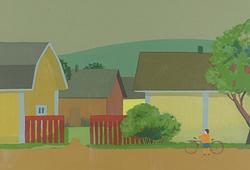Gösta Adrian-Nilsson
Harbor scene with boats
Signed GAN. Executed on the 1910s. Canvas laid on panel, 30 x 23.5 cm.
Provenance
Stockholms Auktionsverk, Moderna kvalitén, 30 October, 2008, cat. no. 594.
More information
When Gösta Adrian-Nilsson, at the age of 14 or 15, saw Marcus Larsson's painting "Sea in Moonlight with Lighthouse and Burning Steamboat" at the Academic Society in Lund, it was a powerful experience for him that later influenced his own creative work. "The spark of the lighthouse disappeared among other sparks, and there was no other salvation for the burning boat than to be crushed against the cliffs... But no painting in the world has CAUGHT me like that, which caught the thirteen-year-old in a breathless moment, when the boundaries of the room were erased and the boy himself became a flame in the flames from the burning steamboat in Marcus Larsson's painting." (GAN in Stockholms-Tidningen's Sunday supplement 19/12 1948)
During the second half of the 1910s, GAN's kaleidoscopic cubo-futurism reached its peak, and his legendary exhibition "Seafarer Compositions" the same year at Gummesons Art Gallery is a milestone in modern art history.
GAN was fascinated by the maritime world, both by sailors and by his hope of being a stowaway on a boat to South America or the South Seas - away from European civilization.
In his diary notes in September 1917, GAN writes that he acquired a model ship named "Elin," which adorned GAN's studio at Kungsbroplan until he moved from Stockholm at the end of May 1919.
In this painting, GAN has brought together different elements from the bustling harbor of the city: a sailboat rocks on the waves with its sails hoisted, the smoke from a steamboat rises in circular shapes towards the sky, and in the background, the city's high-rise buildings form a backdrop. Diagonals intersect throughout the entire composition, threatening to burst the frames. A symbolism of how GAN, in his artistic work, pushed the boundaries and paved the way for something completely new. The three primary colors, red, blue, and yellow, dramatically stand out against the more subdued gray tones, further filling the painting with a vibrant energy.
Artist
Gösta Adrian-Nilsson is most notable as a visual artist, and he is a pioneer of Swedish modernism. He studied at the Tekniske Selskabs Skole in Copenhagen and later for Johan Rohde at Zahrtmann’s school in Copenhagen. As an avant-gardist, Nilsson was constantly searching for new influences. In Berlin, he was influenced by the circle around the radical magazine Der Sturm, through Kandinsky and och Franz Marc. In Paris through Fernand Legér and the artists in his circle. GAN was an eclectic in the positive sense of the word. He took the the artist styles of the 1900s and created new impressions. Symbolism, cubism, futurism, expressionism, constructivim and Theosophy were the colours occupying his internal pallet. He had a sharp eye for the masculine and his painting was often energized by the vitality of modern technology, vibrant eroticism, and echoes of tyrants. No other Swedish modern artist exhibits such a unique style.
Read more









































